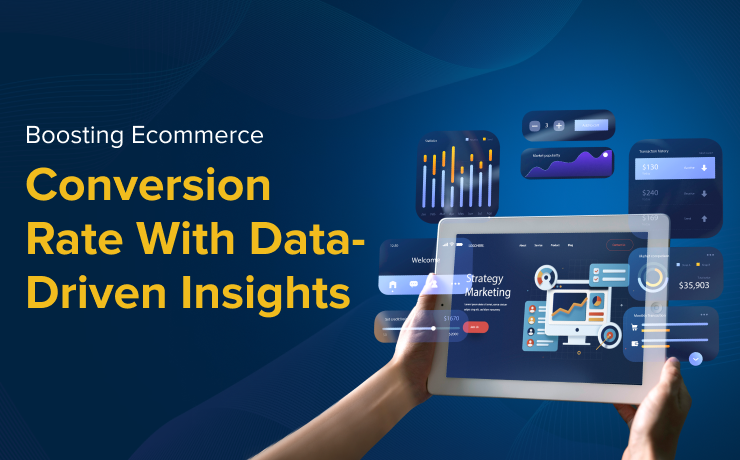
In the highly competitive world of eCommerce, understanding how to increase the conversion rate is crucial for success. Leveraging data-driven insights can provide a powerful edge, helping you identify key areas for optimization and implement strategies that resonate with your audience. A data-driven approach allows you to pinpoint exactly how to increase conversion and effectively boost conversion rate. In this blog, we’ll explore how to increase conversion using data-driven insights, turning valuable information into actionable steps for improving conversion rate and driving growth and profitability.
What is a Conversion Rate and Why is it Important?
Conversion rate is a key performance indicator (KPI) that measures the percentage of visitors to a website who complete a desired action out of the total number of visitors. The formula to calculate conversion rate is:

Improving the conversion rate is crucial for any business as it directly impacts several core aspects of performance:
- Revenue Growth: Higher conversion rates typically lead to increased sales and revenue without necessarily increasing traffic, making it a cost-effective way to grow a business.
- User Experience: A high conversion rate often means a well-designed user experience that meets visitors’ needs and expectations.
- Marketing Effectiveness: It helps in assessing the effectiveness of marketing campaigns, landing pages, and overall marketing strategy.
- Cost Efficiency: Improving conversion rates can lead to better ROI on marketing spend, as more conversions are achieved with the same amount of traffic.
A data-driven approach is essential to understanding how to increase conversion rates effectively. Identifying data-driven insights, allow businesses to make informed decisions to optimize their websites and marketing strategies, ultimately boosting conversion rates.
What Are Conversions on a Website?
Conversions on a website refer to the completion of a desired action by visitors. These actions vary depending on the type of website and its specific goals. Here are some basic examples that apply to different types of websites:
- Ecommerce Sites:
- Purchases
- Add to Cart
- Checkout Initiation
- Content Websites (Blogs, News Sites):
- Subscription Sign-Ups
- Social Shares
- Comments and Engagement
- Educational and Non-Profit Sites:
- Online Donations
- Event Registrations
- Volunteer Sign-Ups
Important Ecommerce Conversion to Track
- Completed Purchases: The primary conversion event for any ecommerce site is the completion of a purchase. This measures the number of visitors who successfully make a purchase.
- Add to Cart: Tracks the number of visitors who add items to their shopping cart.
- Checkout Initiation: Measures the number of visitors who start the checkout process but haven’t completed the purchase yet.
- Email Sign-Ups: Tracks the number of visitors who sign up for the newsletter or email list.
- Account Registrations: Measures how many visitors create an account on the website.
- Use of Discount Codes: Tracks the usage of discount or promo codes during the purchase process.
- Product Reviews/Ratings: Measures the number of product reviews or ratings submitted by customers.
- Wishlist Additions: Tracks how many visitors add items to their wishlist.
- Social Shares: Measures how often product pages or other content are shared on social media platforms.
- Contact Form Submissions/Inquiries: Tracks the number of visitors who submit contact forms or inquiries.
Key Metrics to Monitor and Strategies to Optimize Them for Higher Conversion Rates

1. Average Order Value (AOV)
Average Order Value (AOV) measures the average amount spent by customers in a single transaction on your ecommerce website.
AOV is crucial for ecommerce sites as it directly impacts revenue and profitability. Increasing AOV means generating more revenue from each customer interaction, leading to higher overall sales and improved financial performance.
Optimization Strategies:
- Cross-selling and upselling:
- On-site Recommendations: Display related or complementary products on product pages, cart pages, or during the checkout process. This can be done using product recommendation widgets, “Customers who bought this also bought” sections, or personalized recommendations based on the customer’s browsing or purchase history.
- Email Marketing Campaigns: Send targeted email campaigns to customers based on their purchase history or browsing behavior. Include personalized product recommendations and exclusive offers to encourage additional purchases.
- Personalized Product Suggestions: Deliver personalized product suggestions to customers based on their preferences, purchase history, and browsing behavior. This can be done dynamically on the website or through personalized product recommendation emails.
- Offer Bundle Deals: Promote through email marketing, on-site banners, and social media advertising.
- Free Shipping Thresholds: Highlight in email marketing campaigns, on-site banners, and checkout page messaging.
2. Cart Abandonment Rate
Cart Abandonment Rate refers to the percentage of users who add items to their shopping cart but leave the website without completing the purchase.
Cart abandonment is a significant challenge for ecommerce sites and can result in lost revenue. Understanding and reducing cart abandonment rate is crucial for improving conversion rates and maximizing sales opportunities.
Optimization Strategies:
- Abandoned Cart Recovery Emails: Execute through email marketing automation.
- Simplified Checkout Process: Implement through website optimization and user experience enhancements:
- Minimize Steps: Reduce the number of steps required to complete a purchase. Aim for a single-page checkout or a minimal number of pages where each step is clearly laid out.
- Auto-fill and Address Lookup: Utilize auto-fill technology and address lookup tools to help customers quickly enter their shipping and billing information.
- Clear Progress Indicators: Use visual progress indicators to show customers how many steps remain in the checkout process.
- Simplified Forms: Keep forms as short as possible by only asking for essential information. Use clear, concise labels and input fields.
- Mobile Optimization: Ensure the checkout process is fully optimized for mobile devices, with responsive design and easy-to-use touch inputs.
- Guest Checkout Option: Promote through on-site messaging, email marketing, and PPC campaigns.
3. Product Page Conversions
Product Page actions indicate if visitors find the page valuable and take any actions after viewing the product page.
Product pages play a critical role in the customer journey and directly influence purchasing decisions. Optimizing product page conversions ensures that your product pages are engaging, informative, and persuasive, ultimately leading to higher conversion rates and increased sales.
Optimization Strategies:
- Optimized Product Descriptions and Images: Implement through on-site optimizations and SEO services. Make sure your content is targeting keywords strategically based on the user’s intent and that your images are high quality and have their respective alt tags.
- Customer Reviews and Ratings: Highlight in email marketing campaigns, on-site banners, and social proof elements.
- Call-to-Action Buttons: Test and optimize through website A/B testing and on-site optimization.
4. Checkout Abandonment Rate
Checkout Abandonment Rate indicates the percentage of users who start the checkout process but do not complete the purchase.
The checkout process is the final step in the customer journey and is prone to friction points that can lead to abandoned purchases. Optimizing checkout abandonment rate is essential for reducing barriers to purchase and maximizing conversion rates.
Optimization Strategies:
- Optimized Checkout Form: Implement through website optimization and user experience enhancements.
- Multiple Payment Options: Highlight in email marketing campaigns, on-site banners, and checkout page messaging.
- Security Symbols: Promote through on-site trust badges, security seals, and checkout page messaging.
5. Conversion Rate by Traffic Source
Conversion Rate by Traffic Source measures the percentage of visitors who make a purchase based on different sources of traffic, such as organic search, paid search, or social media.
Understanding conversion rates by traffic source helps ecommerce sites identify the most effective channels for driving sales and allocate marketing resources accordingly. By optimizing conversion rates for each traffic source, businesses can maximize return on investment and drive sustainable growth.
Optimization Strategies:
- Landing Page Optimizations:
- Organic SEO: Optimize landing pages for relevant keywords to attract organic search traffic.
- PPC Campaigns: Create targeted landing pages for each PPC campaign with clear, relevant content that matches the ad copy to improve conversion rates.
- Social Media Advertising: Design engaging and visually appealing landing pages that align with social media ads.
- Targeted Advertising Campaigns:
- PPC Campaign: Use audience targeting options to reach users who are more likely to convert based on their search behavior, interests, and demographics.
- Social Media Advertising: Leverage platform-specific targeting features (e.g., Facebook Lookalike Audiences) to reach potential customers similar to existing high-value customers.
- Display Advertising: Utilize retargeting to reach users who have previously visited the site but did not convert, encouraging them to return and complete a purchase.
- Audience Segmentation:
- Email Marketing Segmentation: Create targeted email campaigns for different audience segments, such as new subscribers, repeat customers, or inactive users. Personalize emails with relevant product recommendations and special offers.
- Personalized Content Strategies: Display personalized product recommendations, special offers, and content that resonates with specific audience groups to improve engagement and conversions.
6. Exit Pages
Exit Pages are the pages from which visitors leave your website. Exit pages provide valuable insights into user behavior and can help identify areas of the website that may need improvement. By optimizing exit pages, ecommerce sites can reduce bounce rates, increase engagement, and retain more visitors, ultimately leading to higher conversion rates and improved user experience.
Optimization Strategies:
- Content and Design Improvements: Implement through website optimization, A/B testing, and UX/UI enhancements.
- Exit-Intent Pop-Ups: Execute through website pop-up tools and email marketing automation.
- Offer Promotions: Promote through email marketing campaigns and on-site messaging.
How ASOS’ Data-Driven Approach Helped Boost Conversion Rates
ASOS, a leading online fashion retailer, has successfully utilized data-driven insights to significantly improve their conversion rates. By adopting a data-driven approach, ASOS was able to understand their customers’ behavior more deeply and implement targeted strategies to enhance user experience and drive sales.
Strategies Implemented:
- Personalized Product Recommendations
- UX A/B Testing
- Enhanced User Experience
- Targeted Email Campaigns
- Mobile Optimization
By implementing these strategies based on the performance of important metrics and the insights from user’s behavior, ASOS saw a substantial increase in their conversion rates. Their ability to adapt the shopping experience to individual customer needs and preferences led to higher engagement, increased average order values, and ultimately, greater revenue growth.
Understanding how to increase conversion rates and implementing these strategies, allow businesses to optimize their website performance, enhance user experience, and ultimately drive more conversions and revenue. Using a data-driven approach allows for continuous improvement and ensures that decisions are based on accurate data-driven insights, helping to boost conversion rates effectively.
 Free
Consultation
Free
Consultation Free
Google Ads Audit
Free
Google Ads Audit








